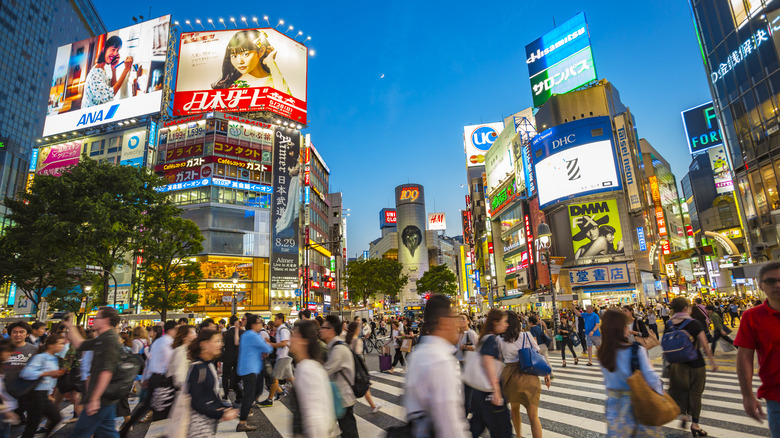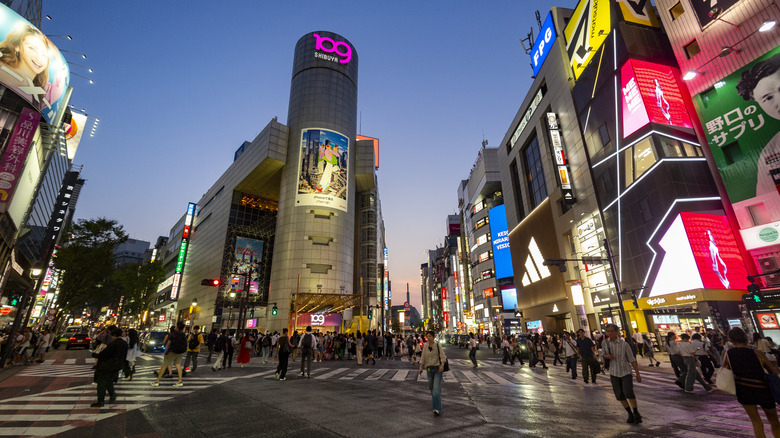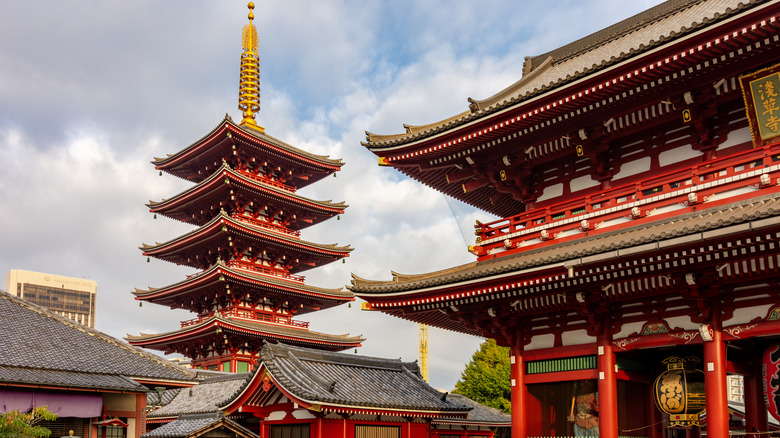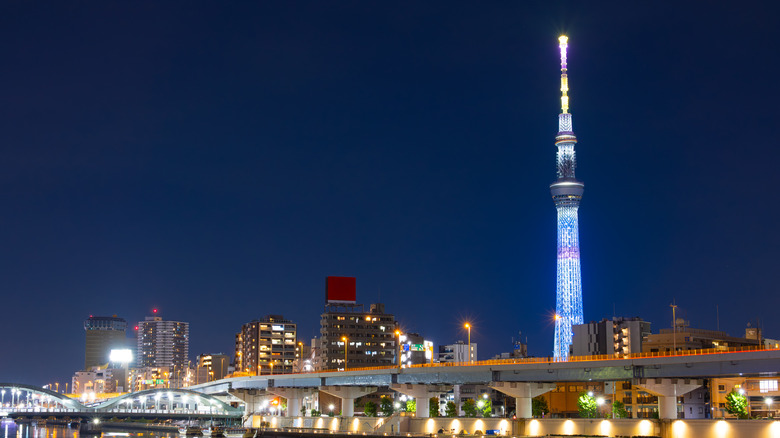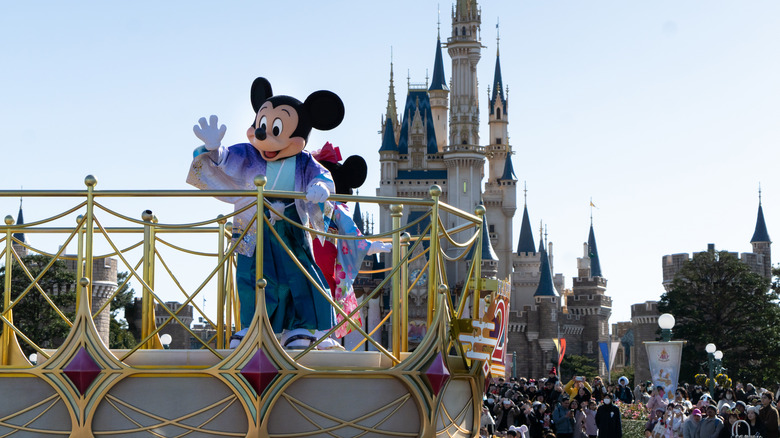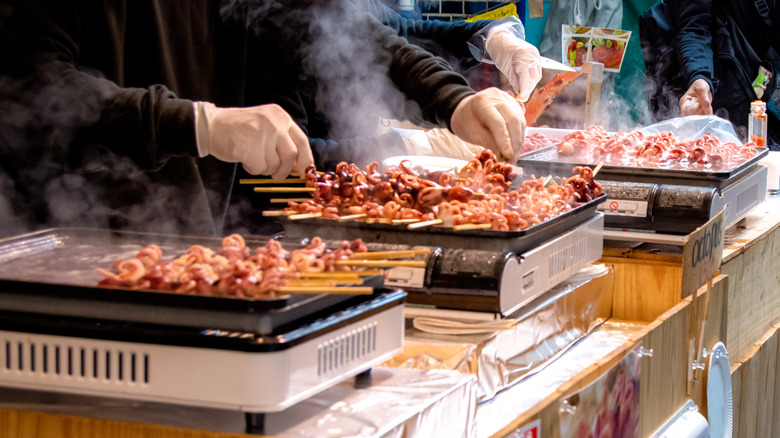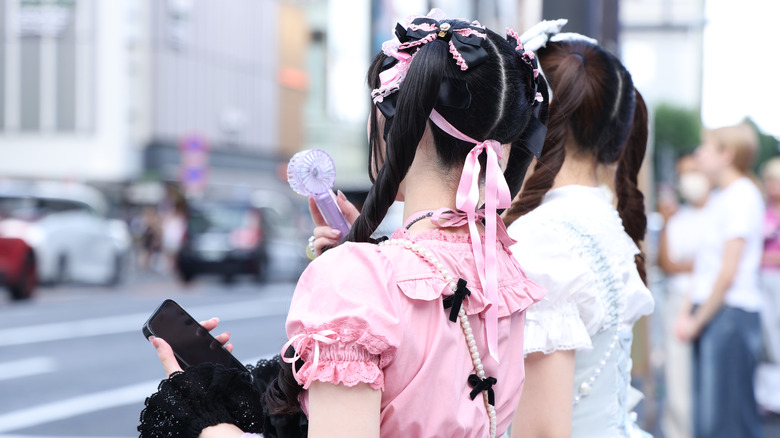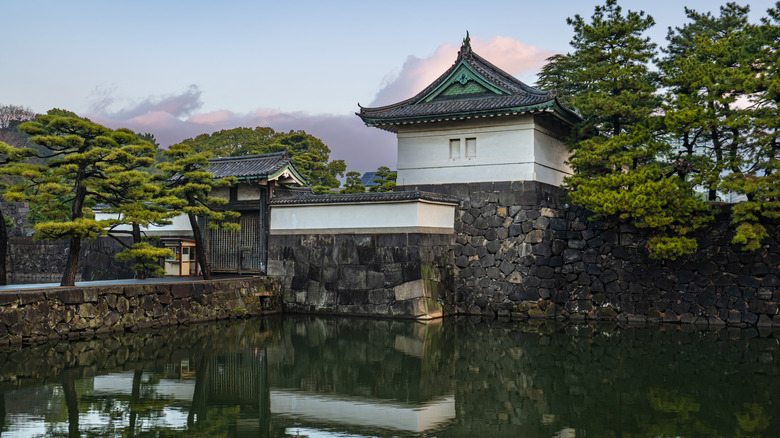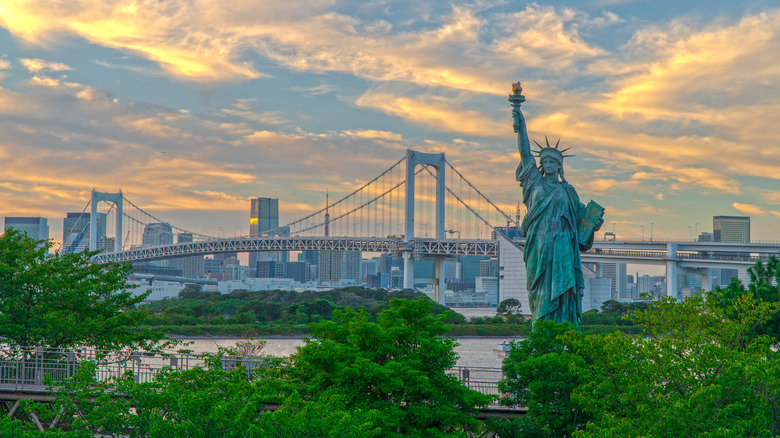Tokyo's 10 Best Sights And Attractions For First-Time Visitors To Explore
Founded in the 12th century, Tokyo is a city where hundreds of years of tradition meld with one of the world's most modern skylines. In a single day, travelers can visit an ancient Buddhist temple at sunrise, go shopping at one-of-a-kind Japanese boutiques after lunch, and end the night at a Michelin-starred dining establishment. Fun fact: Tokyo has more Michelin restaurants than any other city in the world! This mixture of history, pop culture, and elevated living makes Japan's capital absolutely unforgettable.
In this round-up, we'll travel to 10 of Tokyo's best sights and attractions for first-time visitors looking for the best things to do. Each of these sites was chosen because it captures an essential aspect of Tokyo's culture. From a world-famous crosswalk to theme parks, cultural landmarks, and spots for some retail therapy, each of these locations reflects a different aspect of this vibrant city's personality. Together, they will help you plan a first-visit itinerary that showcases the very best that Tokyo has to offer.
Shibuya Crossing
Shibuya Crossing is one of the most widely photographed spots in Tokyo. Regularly featured in global news outlets and in films like "The Fast and the Furious: Tokyo Drift," "Lost in Translation," and "Resident Evil: Afterlife," this crosswalk is an exhilarating introduction to Tokyo's energy, particularly for first-time visitors. Here, seven different intersections converge, and all the lights change simultaneously. The moment pedestrians are allowed to cross, hundreds upon hundreds of people — it is estimated that 1,000 to 2,500 individuals cross together at peak commuting times — flood the road. The scene, as one can imagine, is both chaotic and fascinating.
Travelers can, of course, join the scramble themselves. After all, Tokyo is surprisingly pedestrian-friendly, and walking is one of the best ways to get around. That said, many choose to watch from above to get the best photos. Among the best vantage points are the second, third, and fourth floors at the Starbucks Coffee Shibuya Tsutaya location. If you want a bird's-eye view of the mad rush, the Shibuya Sky building is the highest viewpoint, at 47 stories above the ground.
After taking photos of the famous crosswalks, take some time to explore the surrounding neighborhood — including shops like clothing boutique Pivoine, and Tower Records. For food, check out Uoiki, a restaurant known for its seafood and longstanding operation; the current owner is the fourth generation in his family to run it.
Senso-ji Temple (Asakusa)
Take a step back in time at Senso-ji, Tokyo's oldest temple, built in 628. To enter the temple complex, visitors must pass through a massive red gate known as the "Kaminarimon Gate," or "Thunder Gate" in English. This name refers to the kanji word, "Kaminarimon," written on the gate's centerpiece — a 1,500-pound red lantern. Just past this main gate lies Nakamise-dori, a shopping district where you can peruse local sweets like red bean paste sponge cakes or matcha ice cream, as well as souvenirs including cat sculptures believed to bring good luck, traditional Japanese hair accessories, and much more. Cyouchin-Monaka is one stall that first-timers should definitely visit to try ice cream monaka, which are specialty "ice cream burgers" with rice cakes as "buns."
The main attraction here, Senso-ji Temple itself, is near the end of the shopping area. In the primary temple, there are several notable Buddhist relics, including two calligraphy scrolls from the early 1800s. Additionally, this building houses the Goddess of Mercy Kannon statue — perhaps the most sacred item at Senso-ji — that has been sequestered for over 1,300 years.
In addition to Nakamise-dori and the main temple, visitors can also explore eight other notable sites within the Senso-ji complex. Highlights include the Five-storied Pagoda, originally built in 942 and reconstructed in the 1970s; Bentendo Hall, known for its bell; and the Niten-mon gate, which has been standing since 1649. If you happen to be visiting in March or October, you might even see the Golden Dragon Dance, Senso-ji's semi-annual celebration.
Tokyo Skytree
At over 2,000 feet tall — and roughly 400 feet taller than its rival Taipei 101 — Tokyo Skytree is the nation's highest structure. Offering views of Mount Fuji if conditions are clear, the Skytree has two observation decks, with one about 300 feet above the other. The first overlook, Tembo Deck, takes up three stories of the building, offering stunning views, a section with a glass floor, a souvenir store, and dining. Meanwhile, the second, higher viewpoint is called Tembo Galleria, and features glass walls and a tube-like shape — giving visitors a unique perspective of the city below.
That said, there is more to the Skytree than just views. The primary dining option is the Sky Restaurant 634, an elegant, French-Japanese fusion establishment with lunch and dinner seatings. On nights when the lunar cycle is at its peak, guests can also enjoy the monthly Full Moon Bar, which serves specialty cocktails and screens films. Even when there's not a full moon, evenings at the Tokyo Skytree are an incredible experience with the city lit up below. For those who prefer fun closer to the ground, there are over 300 vendors at the attached Solamachi mall, which sits at the base.
Meiji Shrine
Known for its fast pace of life, Tokyo can be overwhelming for some first-time travelers. That's why it's a good idea to take a breather from time to time — and Meiji Shrine, completed in 1920, offers the perfect opportunity. This calming site is located in a wooded area that will make you feel as though you're miles away from the city center, even though you're under a 20-minute walk from the Shibuya scramble.
Meiji Shrine was built in memory of Japan's first modern ruler, Emperor Meiji, and his wife, both of whom were instrumental in ending the country's isolationism. Today, it serves as a religious site for Shinto practitioners, who often travel here to take part in various rituals.
The Meiji complex hosts numerous events annually — like a coming-of-age ceremony and a doll festival — but it is especially popular for weddings. The most famous Meiji bride is Japan's Princess Ayako, who famously surrendered her royal title to wed a commoner at the shrine in 2018. Couples wishing to tie the knot here can choose from two ceremony sites: the traditional Meiji Jingu Shrine, or the much more modern Gishikiden Hall. Shinto weddings are performed at both locations, with the Shrine providing officiants and musicians. After you visit Meiji Shrine, ease yourself back into a busy day of sightseeing by visiting nearby Yoyogi Park, which was built in the same spot as the 1964 Olympic Village.
Tokyo Disney Resort
Disney is known for its exceptional theme parks around the world, but Tokyo Disney Resort is widely considered one of the entertainment giant's most magical endeavors. Operated in conjunction with the Oriental Land Company, TDR — as it is commonly called in Disney circles — has two parks: Tokyo Disneyland and Tokyo DisneySea. Many Disney fans and industry insiders consider Tokyo DisneySea to be the best individual Disney gate on the planet. This park is comprised of "ports," like Mediterranean Harbor and Cape Cod-inspired American Waterfront, rather than Disney's traditional "lands." The newest addition, 2024's Fantasy Springs port, is a one-of-a-kind area featuring "Frozen", "Peter Pan," and "Tangled." In addition to new rides and dining options, this expansion also included the luxury Fantasy Springs Hotel. Note, however, that only guests are allowed inside the property — even if it's just to take photos.
Tokyo Disneyland, meanwhile, is TDR's "castle park," offering a classic Disneyland or Magic Kingdom vibe. In addition to mainstays like "it's a small world" and Pirates of the Caribbean, it's also home to rides that can't be found anywhere else. Enchanted Tale of Beauty and the Beast, for example, is the only Belle-centric ride at any of Disney's six theme park resorts. Similarly, The Happy Ride with Baymax is another attraction that is unique to Tokyo Disneyland, though it bears similarities to Alien Swirling Saucers at Disney's Hollywood Studios in Florida. As with all Disney Parks worldwide, Tokyo Disney Resort offers annual celebrations, like Disney Christmas and a Halloween experience that typically includes a Villains parade.
Tsukiji Outer Market
In a previous life, the Tsukiji Outer Market was a fresh fish market where tons of seafood was sold every day. Today — although it has become more of a tourist spot in recent years — it is still one of Tokyo's most exciting places to browse, offering great energy and the opportunity to shop alongside locals. The stalls here sell far more than the catch-of-the-day these days, offering everything from handcrafted knives to specialty teas and fresh produce to beautiful Japanese dishes. And while the majority of Tsukiji's vendors sell food and kitchenware, there is even one stall selling clothes.
In addition to selling ingredients, some stalls here also offer ready-made food. In fact, there are almost two dozen sushi shops to choose from — including Shutoku Honten, which dates back nearly 400 years. Additionally, travelers can try popular sashimi rice bowls from 15 different stores, many of which are open seven days a week.
Finally, don't miss the tea rooms and coffee shops that dot the entirety of the Tsukiji Outer Market. Jugetsudo, founded in 1854, is a highlight. This shop offers teas and matcha treats you can take home or consume on-site. Maruni, a matcha company with a global presence, is another great place to stop. For first-time visitors, this market is a great place to sample authentic street food and find unique Japanese souvenirs.
Harajuku and Takeshita Street
For many people around the world, the Harajuku district defines Tokyo's youth culture. The core of the city's avant-garde fashion scene, this neighborhood has become globally famous thanks to the "Harajuku Girls," whose bold styles — including the popular Lolita look — have inspired everyone from Gwen Stefani to Sarah Burton for Alexander McQueen at Paris Fashion Week. The main drag in Harajuku is Takeshita Street. Here, travelers will find every square inch packed with independent boutiques, colorful accessory stores, and a wide range of themed cafes. A few popular spots include the airy Cat Cafe Mocha and Harry Harajuku Terrace, where diners can play with chinchillas and hedgehogs.
If you're on the hunt for wardrobe additions, check out 6% Dokidoki for Kawaii fashion and Sanrio's Cute Cube, where you can pick up a variety of items inspired by Hello Kitty and her friends. There are also dozens of secondhand stores and small boutiques, so you're sure to find something that suits your personal taste.
Beyond the shopping, Harajuku is one of the best people-watching neighborhoods in Tokyo. If you're a photographer, just remember that, as long as you ask for permission, Harajuku Girls are usually willing to take selfies with travelers. There are also plenty of other photo opportunities throughout the area, including storefronts, murals, and pop-up displays perfect for social media. The Harajuku district is located roughly midway between Meiji Shrine and Shibuya Crossing, making it a perfect stop for first-time travelers trying to hit several major spots without making the mistake of underestimating Tokyo's size.
Imperial Palace and East Gardens
Travelers who have an interest in Japan's feudal history will appreciate a visit to the Imperial Palace. Originally called Edo Palace when it was constructed in the late 1450s, this shogunate residence was, at one point, the world's largest castle — outsizing all of Europe's medieval strongholds. Today, the East Gardens, situated in a once-fortified section of the grounds, are one of the main reasons that travelers come to the palace site. Famous for seasonal flower displays and stone ruins — visitors can even scale the remnants of one tower — it's easy to imagine the shoguns who once exerted their military might from this spot.
In addition to exploring the East Gardens, visitors should also stop by the on-site Museum of the Imperial Collections. This museum houses over 20,000 artifacts from not only Japan, but also from nations around the world. Highlights include an 11th-century calligraphy work on the largest remaining scroll of Fujiwara no Kanesuke, a gold-leaf screen featuring a gorgeous dragon and tiger by the famous artist Gantai, and numerous paintings — many of avian species — by Ito Jakuchu, all of which have been designated "National Treasures." If you are planning your first visit to Tokyo within the next year, note that this museum is closed for refurbishment until Autumn of 2026.
Akihabara (Electric Town)
Akihabara, Tokyo's Electric Town, is a paradise for anime, gaming, and electronics enthusiasts. Whether you're a casual fan or live a full-blown Otaku lifestyle, this district is sure to blow you away. If you're in the mood for sensory overload in the best possible way, check out one of Electric Town's multi-story arcades. SEGA's flagship is perhaps the most iconic, but the nine-story GiGO and Namco Arcade are also great options.
Additionally, fans can also browse stores dedicated to a wide range of geeky interests. Visit Ami-Ami to shop for over 30,000 anime figures, Mandarake for all things manga (including super rare items), Super Potato for retro gaming gear, and Sofmap Akiba for high-end computer parts. In short, Electric Town is heaven on Earth for anyone who is passionate about Japanese pop culture.
Between rounds of arcade games and filling shopping bags with treasures, it's a must to dine in Electric Town. The @home cafe is one of the most unique spots to book a table. At this "maid cafe," every guest is treated like royalty from the moment they enter the restaurant. The district is also known for its manga-themed cafes, called "manga kissa" in Japanese. Somewhat akin to early 2000s internet cafes, guests can sit and browse manga while sipping a hot beverage and enjoying a snack. Whether you're a devoted anime fan or you just want to immerse yourself in one of the world's most populous cities' most intense subcultures, Electric City is an unbelievable place to see with your own eyes.
Odaiba Island
Similar to Sentosa Island — a must-see during any first visit to Singapore — Odaiba is Tokyo's manmade entertainment isle. Although it doesn't have a fully-fledged theme park like Sentosa's Universal Studios Singapore, it does boast numerous museums, family-friendly activities, and enjoyable dining options. The Legoland Discovery Center, for example, is a great first stop for brick builders of all ages. Here, over 3 million Legos invite families to spend hours exploring, with some TripAdvisor reviewers noting that they spent almost a full day here. Odaiba is also home to the National Museum of Emerging Science and Innovation, an educational facility that spotlights the many frontiers of science, including aging and robotics.
Once the site of a fortress, Odaiba Island offers a completely different atmosphere from neighborhoods like Shibuya and Akihabara, making it a great destination for first-time visitors looking for a family-friendly day out. Families with children can easily spend a full day or two here without getting bored. In addition to the aforementioned museums, other popular spots include photo ops at a Statue of Liberty replica, Tokyo Joypolis, which offers a variety of theme park simulators and virtual reality games, and Aqua City. For something relaxing, consider the Oedo Onsen Monogatari hot springs complex. If you want to stay overnight on Odaiba Island, there are several hotels to choose from. This includes the Grand Nikko Tokyo and Hilton Tokyo Odaiba, both of which offer incredible views of the skyline and Rainbow Bridge.
Methodology
For this guide, we relied heavily on official websites for various attractions, including the Meiji Shrine, the Tsukiji Market, Tokyo Disneyland Resort, the Tokyo Skytree, and Senso-ji Temple. Additionally, we also consulted local food blogs and review platforms to find popular restaurants and shops that are recommended throughout the guide.
We also frequently used Japan-Guide, Japan's official tourism website, and Tokyo's official tourism website for details about nearly all of the locations featured here. For filler information, we turned to some high-authority lifestyle and fashion magazines, including "Vogue" and "Town and Country."
